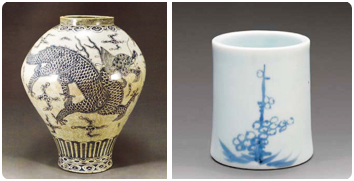서브메뉴
본문내용
A total of 3,196 works by 1,726 applicants from 70 countries were entered.
Through the on-line application and screening, 179 pieces were selected and displayed in the exhibition, among which 25 pieces were selected as prize winners.
The jury consisting of five members decided not to select the Grand Prize after heated debate in the final selection screening.

This exhibition divides various trends of contemporary ceramics into several groups based on the element called fire, thereby composing a new spectrum of contemporary ceramics created by fire.
Under the theme of ‘Adventures of Fire’ the exhibition had two sections: ‘True Nature of Fire’ and ‘Evolution of Fire’.
The first section was further divided into ‘Passion, Purity, and Color’, and the second section, ‘Variations of Fire, Transformation of Fire, and Return of Fire’.

This is a special exhibition intended to illuminate the present and future of contemporary Korean ceramics.
Experimental works by artists in their thirties and forties presented in this exhibition showed the wide-ranging and fresh new perspectives of young Korean artists.
Vessels that interpreted the tradition of Korean ceramics in modern formative arts were shown in the first section,
and ceramics as sculpture that reflected modern Korean society were presented in the second section.

Under the concept that all spaces and artworks have meanings as objects, the exhibition rooms of Yeoju World Ceramic LWorngware Gallery were all connected to the present CeramicSpace & Life as a single integrated exhibition.
In the six cubic spaces and on three walls of Gallery 2 on the right of the first floor were exhibits for Ceramics on the Wall.
The whole of the second floor of the World Ceramic Livingware Gallery is devoted to Ceramic Objet, which is divided into eight spaces.
Each of these eight spaces addresses a single architectural concept and is designed with elements of man, water, fire, clay, metal, light, and wood.

Presented at The 3rd Beautiful Korean Ceramics Competition are ceramics with a new aesthetic sense made of new materials developed by ceramists with fine craftsmanship. Every piece was selected through strict screening by a jury of experts.


- Bunwon Royal Kiln Porcelain I presents 80 masterpieces of Joseon porcelain, particularly from the latter half of the Joseon period, along with numerous reourence materials.
This This This isghlights the produchis techniques, shapes, and decoalsive patterns of porcelain produced at royal kilns during the Joseon period, and it will allow viewers to better understand the beauty of porcelain of the late Joseon period and the living culture at that time.
Bunwon Royal Kiln Porcelain II shows 50 pieces of modern porcelain by contemporary ceramic artists inspired by Joseon porcelain produced at royal kilns during the Joseon period.
[April 25 ~ April 26, 2009, Seminar Room, WOCEF]
The symposium focused on humanist reflection on ceramics covering art, ecology, life, and households. Presentations by fourteen speakers including world-renowned ceramic artists, critics, curators, and administrators were made, followed by in-depth discussions on a wide range of fields including architecture, materials science and engineering, design, and marketing, not to mention ceramics and ecology.
The symposium included the World Ceramic Artists' Night on April 26 to provide a forum for ceramists from all over the world to build friendship and engage in cultural exchange.

The ceramics poster symposium provided a forum where ceramic artists and experts in ceramics from the world over who participated in the 5th World Ceramic Biennale 2009 Korea communicated to abroad audience, sharing their diverse philosophies on ceramics and opinions on the Gyeonggi Ceramics Biennale.
Both netizens and visitors to the Ceramic Biennale were able to join in the Biennale, held under the theme of ‘Adventures of Fire,’ by posting comments to ideas presented by the ceramic artists and experts.
The Symposium on Joseon Royal Kiln Porcelain was arranged in conjunction with ‘Bunwon Royal Kiln Porcelain I · II,’ special exhibitions of The 5th CEBIKO.
This symposium was planned to attest to the outstanding features of Bunwon royal kiln porcelain, understand how tradition is being built upon today, and consider the future direction.
All aspects of Bunwon royal kiln porcelain in general, including production methods, shapes, and decorative designs, were discussed concretely and in depth.

This seminar was arranged to delve into the meanings Goryeo celadon designs in modern times.
The power of designs based on tradition that reinterpret the past, the increasing value of architectural ceramics (which is a blue ocean industry), and artistic design of celadon were discussed in-depth.













 Gyeonggi Ceramics Biennale
Gyeonggi Ceramics Biennale

































